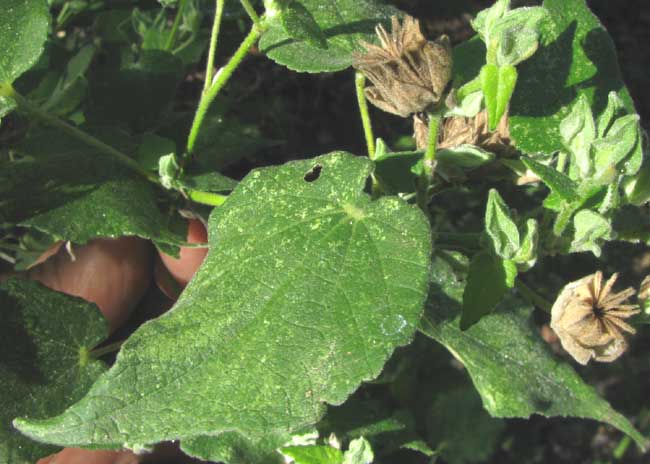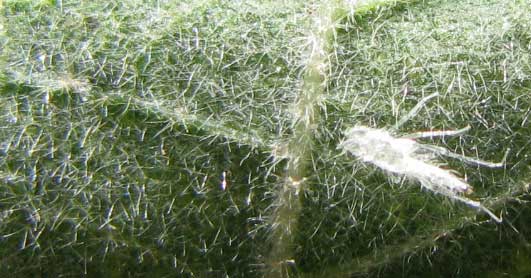Excerpts from Jim Conrad's
Naturalist Newsletter

from the February 27, 2011 Newsletter issued from Hacienda Chichen Resort beside Chichén Itzá Ruins, central Yucatán, MÉXICO; limestone bedrock, elevation ~39m (~128ft), ~N20.676°, ~W88.569°
VELVETLEAF
I forget how many members of the Hibiscus Family with orangish-yellow flowers the size of a dog's eye we've profiled. The Bladder and Viscid Mallows come to mind immediately. When a new one began flowering next to the hut I didn't even bother to check it out -- until I brushed against a leaf and felt how soft-velvety it was. Without diving into the flowers' anatomy already I knew that the plant was a velvetleaf, but it was a velvetleaf unlike the one I know back in the US Southeast, Abutilon theophrasti.
Recognizing it as a velvetleaf isn't a great breakthrough since the velvetleaf genus Abutilon embraces between 100 and 160 species, mostly herbs of tropical and warm temperate areas. The hut one is ABUTILON PERMOLLE, very different from the US species. For one thing, the hut plant stands shoulder high, so it's much larger and bushier. That's a sprig of it at the top of this page.
Those brown things are the fruits, the flowers having passed a week or so ago. A fruit close-up is shown below:

There you're seeing ten separate "carpels," which are a compound ovary's subdivisions. When you cut a tomato across the middle and see its wedge-shaped units with their tips uniting at the fruit's center, each of those wedge-shaped units is a carpel. The difference here is that the carpels grow separate from one another, while in the tomato they're all fused together. Each of the velvetleaf's carpels is in the process of splitting so that the three seeds inside can escape.
The fruit is mightily fuzzy, and the herbage is even more so. Look at the bottom of our velvetleaf's leaf below:

The hairs are soft as well as branched from their bases -- they're "stellate hairs." I hadn't even realized we had an insect in the picture until I saw it on the laptop screen, and I have no idea what it is, just that it looks right for such a fluffy-white landscape.
Abutilon permolle is distributed in Mexico and the West Indies, deep into Central America. It favors well drained limestone soils, like ours.